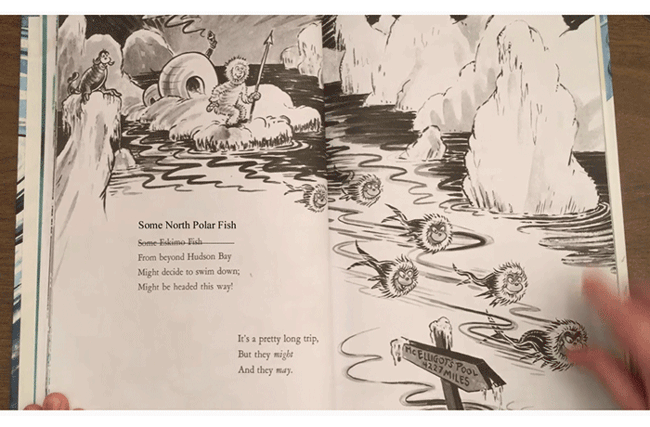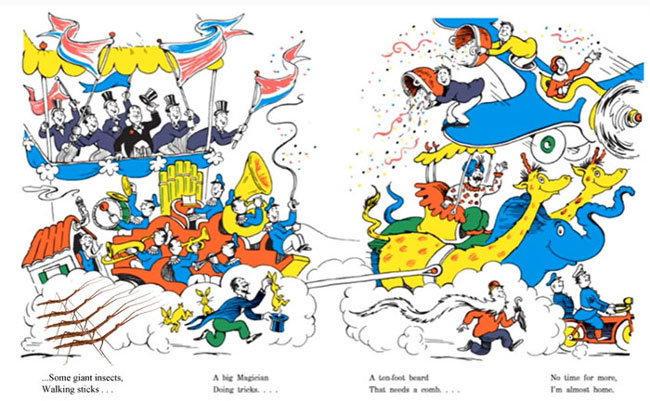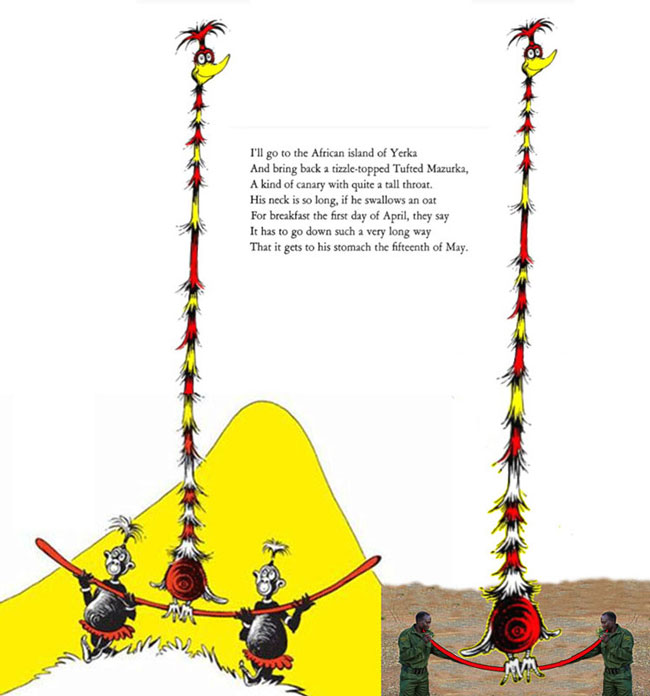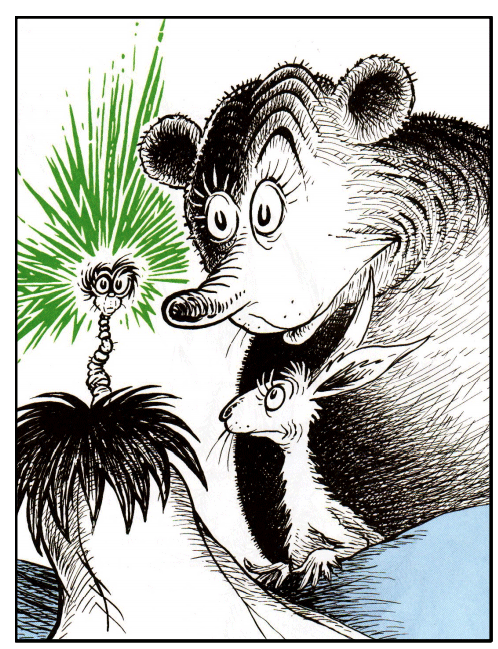|
I Still Love Dr. Seuss A three part article written in March 2021 for Rolla Peace News  Part 1: I Still Love Dr. Seuss Part 1: I Still Love Dr. Seuss
Six books by Dr. Seuss, amazing books of childhood imagination, censored by the “keepers of truth and guardians of beauty” Why? Apparently, they didn't like an image of a young Chinese male eating with chopsticks; so they censored And to Think That I Saw It on Mulberry Street (1937). They didn't like the word “Eskimo” so they censored McElligot's Pool (1947). Both books are about a child's imagination running wild and astounding the “adults in the room.”“Imagination is more important than knowledge. For knowledge is limited to all we now know and understand, while imagination embraces the entire world, and all there ever will be to know and understand.” —Albert Einstein Such arrogance! First: these “keepers of truth and guardians of beauty” are telling young Marco: Imagination is fine, but we'll tell you what you are allowed to imagine. Don't imagine that you saw a “Chinese boy who eats with sticks;” Don't imagine that you might catch an “Eskimo Fish.” Such imaginings will not be permitted. Second, these “keepers of truth and guardians of beauty” are reaching far back into the past and telling authors long deceased what they are allowed and not allowed to write. In the case of McElligot's Pool (one of my favorites) those who are presently choking our oceans with plastics and literally killing the fish through global warming and acidification are telling young Marco, almost 75 years in the past, don't imagine that there are Eskimo Fish in the ocean. Such arrogance! But, as young Marco replies to the farmer who tells him he is a fool to try to catch fish in McElligot's Pool: Some might argue that a stereotypical image of a Chinese youth eating with chopsticks is hurtful. It certainly wasn't meant to be. In the 1930s China was a land of mystery. About all that many in the United States knew of Chinese people back then was that they have somewhat flatter faces than Caucasian people and eat with chopsticks.“Oh, the sea is so full of a number of fish, Some might argue that the word, Eskimo, is hurtful. It certainly wasn't meant to be hurtful. In fact, at the time, it was the only word many of us knew for peoples who lived above the Arctic Circle. It wasn't until much later in life that I learned names like Inuit, Aleut, Yupik and Sami. So, how are we to deal with changing perceptions of what might be hurtful? I've spent 19 years volunteering in schools reading to young children. If I think an image is inappropriate, I simply skip that page or, using a photo-manipulation program, change the page to something I feel more appropriate. If I think some words are inappropriate, I change them. (Actually, I rarely read stories. Instead, I tell the story, usually in my own words, particularly if I think some of the written words might be inappropriate.) Here's a page from McElligot's Pool with “Eskimo Fish” replaced by “North Polar Fish.” 

My favorite Dr. Seuss story is Bartholomew and the Oobleck. I think it's at least as important an environmental allegory as The Lorax and I think that having the hero of the story being the same age as my audience is very helpful in keeping their attention. For those not familiar with the story: I particularly like the ending. I think children deserve a happy ending. There is far to much unhappiness in the world already; and many children have already encountered far too much of it. I think Dr. Seuss might have agreed.King Derwin wants something new to fall from His sky. He calls his royal magicians and they make oobleck fall. Oobleck is green, gooey and sticky. There seems to be no way to stop the oobleck until the page boy, Bartholomew, gets the king to cry, “It's all my fault and I'm sorry. I'm awfully, awfully sorry!” Then the oobleck magically stops falling and melts away. Another facet of this story that I like is that it shows that children can change the world. After King Derwin and his magicians (scientists, as I tell the story) almost destroyed the world, Bartholomew sets everything right again by looking the king in the eye and telling him “You might be a mighty king. But you're sitting in oobleck up to your chin. And so is everyone else in your land. And if you won't even say you're sorry, you're no sort of a king at all.” (Perhaps, Greta Thunberg had this story in mind when she chastised our modern-day royalty: “People are suffering. People are dying. Entire ecosystems are collapsing. We are at the beginning of a mass extinction and all you can talk about is money and fairytales of eternal economic growth. How dare you!”) I think youth are learning that they can change the world. Perhaps, Dr. Seuss has helped to show them the way. Notes on the word, “Eskimo”: Note 1: There is an extensive discussion on Wikipedia of the word, Eskimo, which is viewed in Canada and elsewhere as a derogatory term. According to this article:  Part 2: From Our Readers: More on Dr. Seuss and Racism Part 2: From Our Readers: More on Dr. Seuss and Racism
Several readers wrote in to say they approved of my defense of Dr. Seuss last week. One reader writes: My response: Here's another example:“I agree wholeheartedly with your defense of Dr Seuss. What are we doing right now that future generations may one day condemn and insist our whole culture must be cast in the river? I can hear it now: Do you know what these ignorant ancestors did? They raised animals, fed them and cared for them, and then--brace yourself--ATE THEM. Don't shake your head in disbelief, look it up!” Another reader wonders if the reasons for censoring the Dr. Seuss books were all like the examples I gave last week [the word “Eskimo” in McElligot's Pool and the image of a “Chinese boy who eats with sticks” in And to Think that I Saw It on Mulberry Street] or were any more serious.“Do you know what these ignorant ancestors did? They made bombs that could destroy all human life on Earth. And then they threatened each other that if they didn't get their way they would explode them!! Don't shake your head in disbelief, look it up! It's a miracle that any of us are still alive today.” My response: Most were similar. However, I found this image from “If I Ran the Zoo” extremely offensive. I would not show this image to young children. I've given considerable thought to this question since then. I am in no position to decide for anyone else what they should or should not find hurtful. The last thing I would want to do is hurt any of the children I read to, or their teachers, parents or caregivers; so I try to be attuned to what might be hurtful and try to be proactive. I don't always succeed. Here's an example. I used to read a book entitled Moe Q. McGlutch, He Smoked Too Much — about a wealthy donkey who chain-smoked and his non-smoking zebra cousins. One day, I looked at a girl whose clothes smelled strongly of second-hand smoke and wondered how the book made her feel. I decided to stop reading it. How would it feel to have your parents characterized as donkeys in front of the whole class? There must be better ways to teach children not to take up harmful habits than to be hurtful to children of heavy smokers. It's not their fault. They didn't ask to be born into a family of smokers. Is this censorship? I don't think so. There are thousands of stories. We story-tellers choose which ones we tell; and, unlike the act of reading, the telling of a story is personal — it becomes ones own. So changing the words or the images are more acts of personalization than of censorship. I feel under no obligation to the author to tell the story the way it was written. Among pre-literate cultures, story-tellers were among the most revered members of the tribe. An Example: Sam and the Tigers (aka The Story of Little Black Sambo) I love this story. I use very little of the original Helen Bannerman (1899) book except the story itself. The images I use are from Christopher Bing's 2003 book that retains Bannerman's words. The name is from Julius Lester's 1996 retelling of the story. The telling is mostly my own. Nice story. And it has a moral. Diplomacy works where brute force fails. And you're never too young to be a diplomat. Nothing offensive here, unless you're a tiger. Hard to remember that the original book was branded as racist and censored.Sam is on his way to school. It's his first day of kindergarten and he's dressed in his new clothes. He meets four tigers. Each one growls, “Grrrr, Sam I'm going to eat you for breakfast.” Sam gives each tiger an article of clothing and exclaims, “Oh, Mr. Tiger, you're the best dressed tiger in the whole jungle.” The tiger is proud of his new clothes and doesn't eat Sam. (By time we get to the third tiger, most of the class has these two lines down pat.) Racism is a difficult subject. So much is subjective and has to do with intent and perception rather than outward form. Objective forms of racism are much easier to deal with; but subjective forms are far more insidious. I think choosing stories that give a positive image of unfamiliar peoples and cultures are far more effective than censorship. Here's my favorite book with a Chinese theme: Dragon Soup by Arlene Williams and Sally J. Smith Perhaps, if we had been reading children books like this instead of focusing on an image in a Dr. Seuss story, the eight who died in the recent Asian massage parlors shootings would still be alive.Tonlu works the family farm with father, mother and her five younger siblings. The farm is on the side of a steep mountain. At the top of the mountain live the immensely wealthy cloud dragons. When Tonlu finds out the merchant will foreclose on their farm unless she marries him, she decides to steal treasure from the cloud dragons to pay the merchant. And my favorite book about Arctic peoples is Lydia Dabcovich's The Polar Bear Son. There are so many different cultures from which I'd like to have good stories. I'm always looking for new books. It makes me sad that I have so few.An old woman with no children to care for her adopts a young polar bear. The polar bear grows up quickly and becomes the best provider of fish and seal meat in the village. Even after the villagers drive the bear out, the polar bear son continues to catch fish and seal for his mother. These days, when we must all work together in the face of so many threats, from militarism to climate change to emergent diseases, positive stories like these send a powerful message of cooperation and understanding.  Part 3: Still More on Dr. Seuss and Racism Part 3: Still More on Dr. Seuss and Racism
Last week I included a link to an image from Dr. Seuss's If I Ran the Zoo with a comment that I found this image, which contains two black Africans with monkey faces, naked except for a grass skirt and a ridiculous-looking top-knot, extremely offensive. This week I offer an alternative image (below). I do not think this new image adds or subtracts one iota from the story-line. (Gerald McGrew imagining what fantastic creatures he would put in his zoo.)  (Which is Dr. Seuss's and which is mine?) It's interesting to note that most (if not all) of Dr. Seuss's images are caricatures and yes, caricatures can be offensive, and yes, we should be careful about how we use them. As a lover of earthworms, perhaps I should be offended by this ridiculous looking worm with huge round eyes from The Big Brag. I'm not. (Read this wonderful story to find out why.)  (Incidentally, worms don't have eyes, although they can sense light and dark.) I recommend to Dr. Seuss Enterprises that they redraw any questionable images and then republish the six books that they have discontinued. There is a precedent for this. Dr. Seuss's Hooray for Diffendoofer Day (another of my favorites) was published posthumously with help from two friends. And, to close, here is a verse on reading Dr. Seuss: Oh, the world is so full of a number of books; |